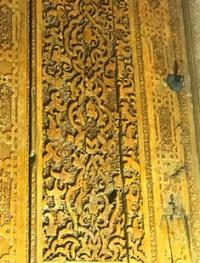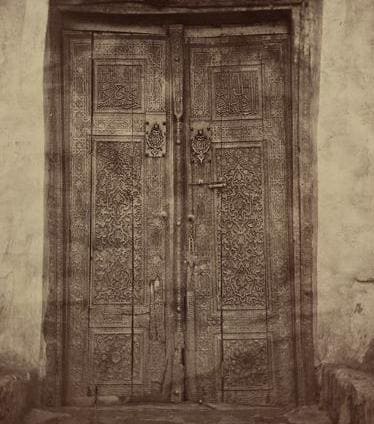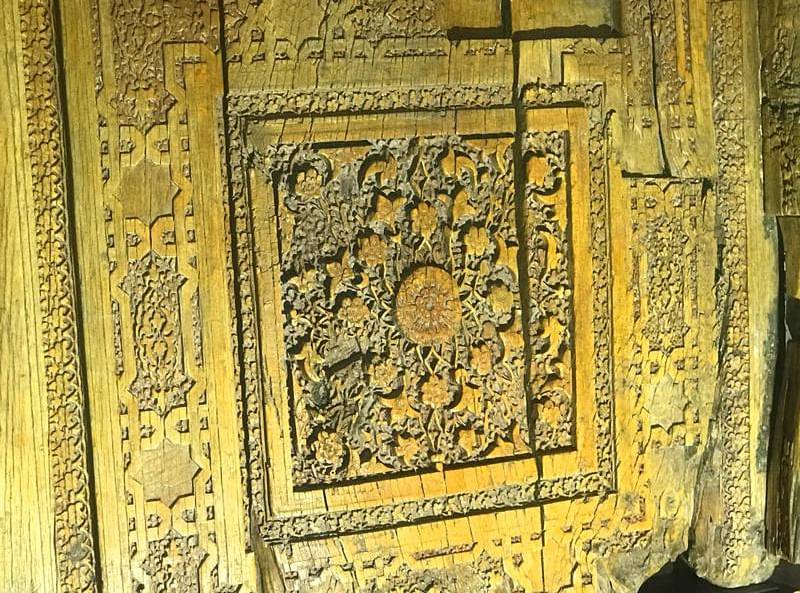You are here
Outside door of mausoleum of Akhmed Yasavi.

Visit to mausoleum of Ahmed Yasawi.
“August 25th. Having crossed a stream or a very large irrigation ditch, we drove up to the last station before Turkestan. Karatau became clearly visible, which is why the steppe landscape lost its tiring appearance and was replaced by an excellent mountain landscape. Dark gorges ran along the transparent blue color of the mountains, lighter ledges with black gullies on the sides were drawn.
Thank God! We are approaching the mountains again! Far away near them, the gardens of Turkestan darkened, where greenery was shaded in groups on the light steppe with grass burnt on it. Melons appeared near the road.
Ahead rose a high arch and a dome of the famous Turkestan mosque, or the so-called Azret. How pleasant all this is to the eye, accustomed to the monotony of the steppe! It's like driving up to Paris; at least I experienced such a feeling of pleasure, approaching Turkestan.
The lively look increased as we moved forward. On the road, riders scurried about on donkeys, horses and camels. Not smeared carts, harnessed to one horse, on which a man was sitting, were taken to the city jumurchka (clover), watermelons, sacks of millet..."
“Diary of 1866. Travel to Turkestan ". Alexander Konstantinovich Gaines (1833 - 1893).
Architectural landmarks of mausoleum of Ahmed Yasavi.
In the mausoleum of Khoja Ahmed Yasaui, two doors have been preserved since the XIV century. These are the door of the central hall of Zhamagatkhany (Kazandyk), which is called "Kakaya" ("Gate") and the door of the "Kapsyrma" ("Brace") burial vault.
A two-leaf door leading to Zhamagatkhanu (Kazandyk) - "Kakpa" (dimensions 3.7 x 2.1 meters) - is located in the depths of the portal of the southern facade. The outer door is currently located in the niche of the portal of the huge aivan arch (a vaulted hall with one open end, surrounded by walls on three sides).
Despite the damage, the wood panels with luxurious carvings are well preserved on the two doors. The center panels are larger than others and have the most sophisticated design, consisting of intertwining floral arabesques and lotus designs.
The bottom panels are rounded. They contain an intricate pattern of eight-pointed stars radiating from the center. The upper panels contain geometric motifs with handwritten Arabic script. The panels are bordered by stripes of intricate intersecting geometric shapes. The astonishing mastery of the door design is suggestive of a heavenly gate.
This is the central front door. The ornamentation on the outside of the door is divided into three parts, each of which is separated from each other by a patterned (embossed) belt. Translations of inscriptions on the door:
“Words to Allah Almighty for everything (sent down)! Praise be to Allah Almighty for everything sent down.
"The gate of the saints is the source of happiness, love for the saints is the key to happiness!"
"The servant of your (sacred) threshold, let him be in abundance!"
In the middle of the door, on quadrangular bronze plates, there are two bronze rings - tracing - devices for knocking. An inscription in Persian and Arabic is engraved on the edges of the rings and in the upper
art of the plate.
Translations of inscriptions:
“Prophet, peace be upon him! Said "This world is fleeting, turn it into obedience to God -" Our goal is the patterns (of life) that will remain after us. "
For I do not see being eternal.
Maybe someone is the ruler of the heart with affection.
One day he will pray for (this) poor man. "
Saadi, the poem "Gulistin".
“In the year seven hundred and ninety-nine (1396 - 1397), Izz ad-din ibn Taj ad-din al-Isagi, who was weak and asking (forgiveness from God), made (her). There will be this door for achieving joy and always bringing good, open for friends, and closed for enemies! "
Geographic coordinates of mausoleum of Khoja Ahmed Yasawi: N43 ° 17'51.69 "E68 ° 16'15.06"



Authority:
sold-out at the excavation of the mosque.
Photos by
Alexander Petrov.
Photos
used from Turkestan Album. Archaeological part of "Turkestan Album". Six volumes of photographic research were prepared and published in 1871-1872. under the patronage of General Konstantin P. von Kaufmann, the first governor-general (1867 - 1882) of Turkestan, as the territory of Central Asia that belonged to the Russian Empire was called at that time.







